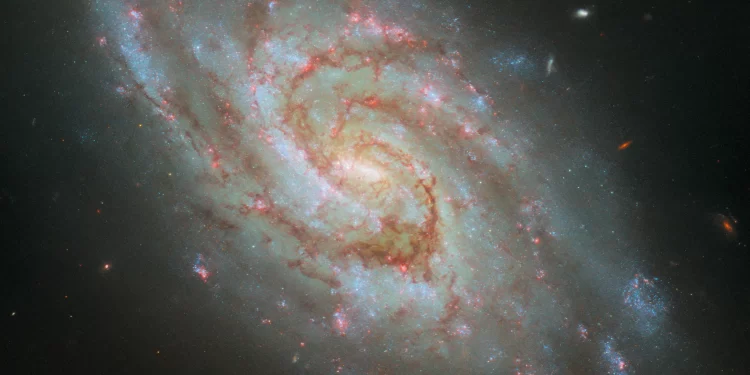The vastness of space continues to inspire awe as astronomers uncover breathtaking views of distant galaxies. One of the latest captures from NASA’s and ESA’s Hubble Space Telescope offers a stunning glimpse into the spiral galaxy IC 1954. Located approximately 45 million light-years away in the constellation Horologium, IC 1954 showcases a majestic combination of cosmic features. With a glowing bar of stars at its core, spiraling arms, and dark dust clouds, the galaxy presents an intricate pattern of activity that hints at deeper mysteries.
A striking feature of IC 1954 is its numerous pink regions scattered across the galaxy’s disk. These glowing spots, known as H-alpha regions, are star-forming nebulae that emit red light. This visible radiation offers a window into the birthplace of stars, providing astronomers a valuable tool for studying stellar nurseries in distant galaxies.
Some astronomers suggest that the prominent “bar” at the center of the galaxy could be more than just a visual spectacle. It’s believed that this structure may represent an energetic star-forming zone that aligns with the galaxy’s core, marking an intense period of stellar creation. This theory underscores the dynamic processes occurring within galaxies like IC 1954, where cosmic forces shape the formation of new stars.
The Energetic Heart of IC 1954
The image of IC 1954 is part of a larger collaborative effort involving multiple world-class observatories, including Hubble, the James Webb Space Telescope (JWST), and the ground-based Atacama Large Millimeter/submillimeter Array (ALMA). Together, these observatories are surveying more than 50 nearby galaxies, collecting data across the electromagnetic spectrum—from radio waves to ultraviolet light. The aim is to create a comprehensive map of how matter moves through galaxies, charting the flow of interstellar gas and dust and providing insights into the formation and evolution of stars.
Hubble’s ability to observe galaxies in ultraviolet and optical wavelengths plays a crucial role in this survey. By capturing the brightest young stars and star clusters, and using its specialized H-alpha filter to track emissions from star-forming nebulae, Hubble contributes invaluable data. This vast dataset will serve as a foundation for future astronomical research, with the JWST expected to build on these findings as it continues its mission.
The collaboration between these powerful observatories is paving the way for groundbreaking discoveries about the evolution of galaxies and their star-forming regions. The data being collected is not only revealing the past but is also providing clues about the future of galactic development. As astronomers continue to analyze this wealth of information, new theories and models will likely emerge, reshaping our understanding of how the universe works.
The journey of matter from star to star, the role of interstellar dust, and the birth of new stars are all part of the grand cosmic story unfolding in galaxies like IC 1954. As Hubble, JWST, and ALMA continue to explore the cosmos, the mysteries of the universe will come into even sharper focus.











